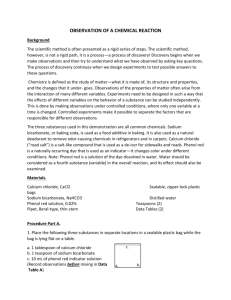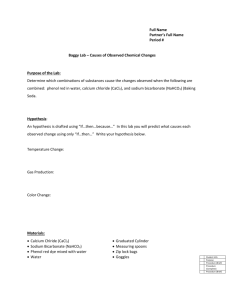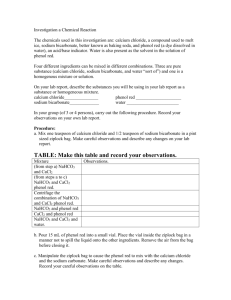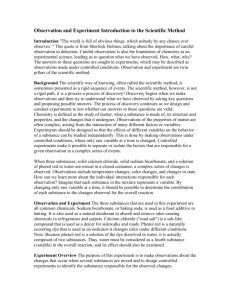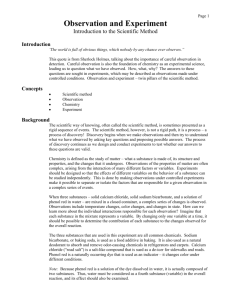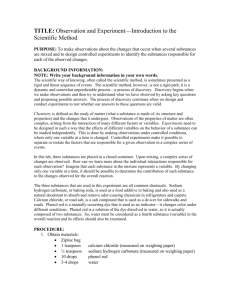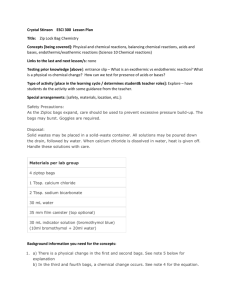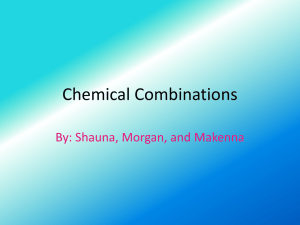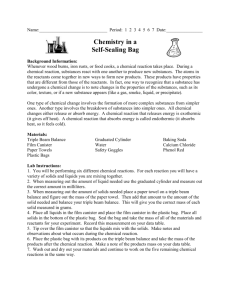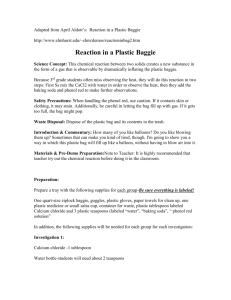File - Herriman Science
advertisement
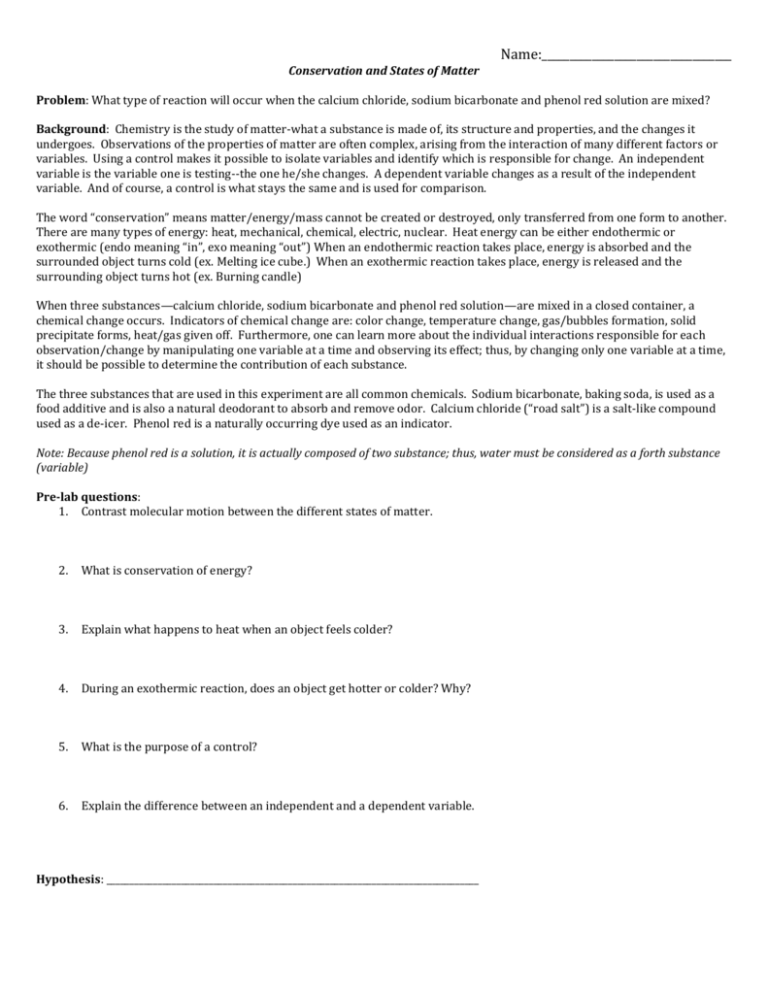
Conservation and States of Matter Name:__________________________________ Problem: What type of reaction will occur when the calcium chloride, sodium bicarbonate and phenol red solution are mixed? Background: Chemistry is the study of matter-what a substance is made of, its structure and properties, and the changes it undergoes. Observations of the properties of matter are often complex, arising from the interaction of many different factors or variables. Using a control makes it possible to isolate variables and identify which is responsible for change. An independent variable is the variable one is testing--the one he/she changes. A dependent variable changes as a result of the independent variable. And of course, a control is what stays the same and is used for comparison. The word “conservation” means matter/energy/mass cannot be created or destroyed, only transferred from one form to another. There are many types of energy: heat, mechanical, chemical, electric, nuclear. Heat energy can be either endothermic or exothermic (endo meaning “in”, exo meaning “out”) When an endothermic reaction takes place, energy is absorbed and the surrounded object turns cold (ex. Melting ice cube.) When an exothermic reaction takes place, energy is released and the surrounding object turns hot (ex. Burning candle) When three substances—calcium chloride, sodium bicarbonate and phenol red solution—are mixed in a closed container, a chemical change occurs. Indicators of chemical change are: color change, temperature change, gas/bubbles formation, solid precipitate forms, heat/gas given off. Furthermore, one can learn more about the individual interactions responsible for each observation/change by manipulating one variable at a time and observing its effect; thus, by changing only one variable at a time, it should be possible to determine the contribution of each substance. The three substances that are used in this experiment are all common chemicals. Sodium bicarbonate, baking soda, is used as a food additive and is also a natural deodorant to absorb and remove odor. Calcium chloride (“road salt”) is a salt-like compound used as a de-icer. Phenol red is a naturally occurring dye used as an indicator. Note: Because phenol red is a solution, it is actually composed of two substance; thus, water must be considered as a forth substance (variable) Pre-lab questions: 1. Contrast molecular motion between the different states of matter. 2. What is conservation of energy? 3. Explain what happens to heat when an object feels colder? 4. During an exothermic reaction, does an object get hotter or colder? Why? 5. What is the purpose of a control? 6. Explain the difference between an independent and a dependent variable. Hypothesis: ________________________________________________________________________________ Materials (for each trial): 1 tsp of calcium chloride 5 mL phenol red solution 0.5 tsp sodium bicarbonate Ziplock bag Plastic spoon Electronic scale Graduated cylinder Weighing boats (2) Procedure: 1. Label 2 weighing boats (calcium chloride, sodium bicarbonate) 2. Measure out 1 scoop of calcium chloride, observe and record mass(NOTE: YOU MUST TARE INSTRUMENT BEFORE WEIGHING CHEMICALS) 3. Measure out 0.5 scoops of sodium bicarbonate, observe and record mass 4. Measure out 5 mL of phenol red solution, observe and record mass 5. Measure and record the mass of an empty ziplock bag. 6. Lay the Ziploc bag flat and place the 3 substances in separate locations. See diagram a. Calcium chloride b. Sodium bicarbonate c. Phenol red solution 7. Squeeze out as much air as possible and allow contents to mix. 8. Record observations and record final mass 9. Throw Ziploc bag away 10. Repeat the experiment 2 more times 11. Follow steps 5-9 for each new test Observations: Chemical Calcium chloride Sodium bicarbonate Phenol red What happens when Chemical are mixed? Observations-Qualitative Data: Table I Chemical 1. Mass of calcium chloride 2. Mass of sodium bicarbonate 3. Mass of phenol red 4. Mass of empty Ziploc bag 5. Total mass (1+2+3+4) 6. a. Mass of mixture b. Difference between beginning mass and ending mass (5-6a.) c. Was conservation of mass observed? Quantitative Data Table II Chemical 1. Mass of calcium chloride 2. Mass of sodium bicarbonate 3. Mass of phenol red 4. Mass of empty Ziploc 5. Total (1+2+3+4) 6. a. Mass of mixture b. Difference between beginning mass and ending mass (5-6a.) c. Was conservation of mass observed? Table III Chemical 1. Mass of calcium chloride 2. Mass of sodium bicarbonate 3. Mass of phenol red 4. Mass of empty Ziploc 5. Total (1+2+3+4) 6. a. Mass of mixture b. Difference between beginning mass and ending mass (5-6a.) c. Was conservation of mass observed? Quantitative Data Quantitative Data Analysis: 1. What type of reaction was this (physical/chemical)? Cite evidences 2. Was this type of reaction endothermic or exothermic? Cite evidences 3. How was your precision? Calculate the average value of part 6b from your data tables. Discuss your findings. 4. Was conservation of mass/matter/energy observed? Cite evidences 5. What evidence suggests a new chemical substance was produced? Conclusion/Reflection: Lab Rubric-Conservation Lab Category Procedure Data/ observations Analysis Reflection Description Did you answer your pre-lab questions? Did you follow procedures correctly? Did you adhere to all safety protocol? Did you wear your apron and goggles? Did you clean up and dispose of chemicals properly? Did you record your data accurately? Do you show proper significant digits and unit of measurements? Do you have a table to display your data? Did you quantify your calculations correctly? Do you understand what your observed? Can you draw a conclusion? Are your analysis values visible? Did you use complete sentences? Are there at least 5 sentences? Did you mention your possible reasons for error? Did you mention what you did well? Could improve on? Did you say what you learned? Total (30) 20% (6 pt) 50% (15 pt) 10% (3 pt) 20 % (6 pt) Your score

